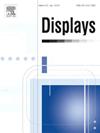Visual perception and user experience Optimization: Exploring interaction design through static-triggered smooth pursuit systems
IF 3.7
2区 工程技术
Q1 COMPUTER SCIENCE, HARDWARE & ARCHITECTURE
引用次数: 0
Abstract
This study investigates optimization strategies for smooth pursuit eye movements in eye-controlled interactive systems, aiming to enhance task efficiency and user experience. To address challenges such as visual clutter and cognitive load, a novel static-triggered smooth pursuit design is proposed. In this approach, interactive elements remain static until gaze contact initiates movement, after which they accelerate uniformly to a predefined maximum speed. The study employs an experimental methodology to evaluate the effects of three key parameters—acceleration duration, tracking speed, and required trigger duration—on visual search task performance and subjective user experience. Results indicate that the optimized interaction model significantly reduces task completion time and error rates, improving system accuracy. Optimal performance was achieved with a 0.5-second trigger duration, a tracking speed of 5 deg/s, and a 1-second acceleration duration. Longer trigger durations minimized erroneous activations, while moderate tracking speeds and gradual acceleration enhanced user control and reduced compensatory eye movements. Subjective evaluations confirmed improvements in visual perception, comfort, and user satisfaction. The proposed design offers practical guidelines for developing advanced eye-controlled systems, providing a theoretical foundation for enhancing interaction efficiency and user experience in smooth pursuit tasks, and advancing intelligent human–computer interaction systems.
视觉感知与用户体验优化:通过静态触发平滑追踪系统探索交互设计
本研究旨在探讨眼控交互系统中平滑追踪眼动的优化策略,以提高任务效率和用户体验。为了解决视觉混乱和认知负荷等问题,提出了一种新的静态触发平滑追踪设计。在这种方法中,交互元素保持静态,直到凝视接触启动运动,之后它们均匀加速到预定义的最大速度。该研究采用实验方法来评估三个关键参数——加速持续时间、跟踪速度和所需触发持续时间——对视觉搜索任务性能和主观用户体验的影响。结果表明,优化后的交互模型显著降低了任务完成时间和错误率,提高了系统精度。在0.5秒的触发持续时间、5度/秒的跟踪速度和1秒的加速持续时间下,实现了最佳性能。较长的触发持续时间最大限度地减少了错误的激活,而适度的跟踪速度和逐渐加速增强了用户的控制,减少了补偿性眼球运动。主观评价证实了视觉感知、舒适度和用户满意度的改善。该设计为开发先进的眼控系统提供了实践指导,为提高流畅追踪任务的交互效率和用户体验,推进智能人机交互系统提供了理论基础。
本文章由计算机程序翻译,如有差异,请以英文原文为准。
求助全文
约1分钟内获得全文
求助全文
来源期刊

Displays
工程技术-工程:电子与电气
CiteScore
4.60
自引率
25.60%
发文量
138
审稿时长
92 days
期刊介绍:
Displays is the international journal covering the research and development of display technology, its effective presentation and perception of information, and applications and systems including display-human interface.
Technical papers on practical developments in Displays technology provide an effective channel to promote greater understanding and cross-fertilization across the diverse disciplines of the Displays community. Original research papers solving ergonomics issues at the display-human interface advance effective presentation of information. Tutorial papers covering fundamentals intended for display technologies and human factor engineers new to the field will also occasionally featured.
 求助内容:
求助内容: 应助结果提醒方式:
应助结果提醒方式:


